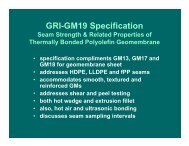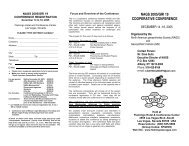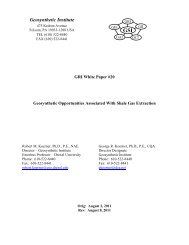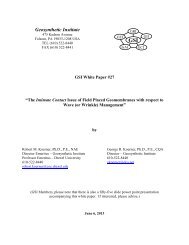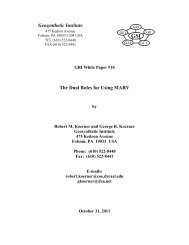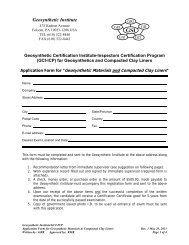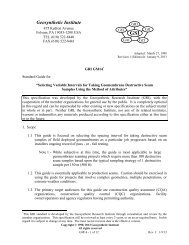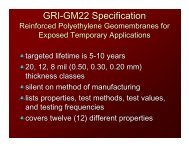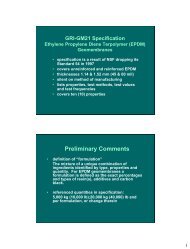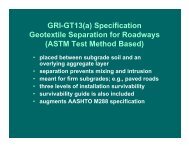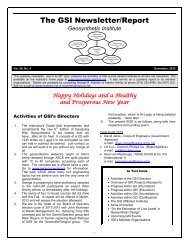GCL Design Guide - The Geosynthetic Institute
GCL Design Guide - The Geosynthetic Institute
GCL Design Guide - The Geosynthetic Institute
You also want an ePaper? Increase the reach of your titles
YUMPU automatically turns print PDFs into web optimized ePapers that Google loves.
with a lower mass per unit area may create higher bentonite internal erosion as<br />
one would expect with coarser subgrades or over geonets. <strong>Geosynthetic</strong>s with<br />
higher mass per unit area geotextiles are likely to be more protective against<br />
erosion. One would also expect this with finer subgrades. Additionally, the effect<br />
of the hydraulic gradient needs to be considered in such investigations.<br />
Note 10: <strong>The</strong> bentonite erosion issue is somewhat mitigated when using a<br />
GM/<strong>GCL</strong> composite or multicomponent <strong>GCL</strong> instead of a <strong>GCL</strong><br />
by itself.<br />
11.5 Total Settlement and Differential Settlement—<strong>GCL</strong>’s (as with all geosynthetics in<br />
a layered liner system) will often be subjected to total settlement and/or<br />
differential settlement. Of the various applications mentioned in Sections 5 and 6,<br />
landfill covers and waste covers are of the greatest concern.<br />
Note 11: Depending upon site-specific subgrade conditions any, or all, of<br />
the applications of Sections 5 and 6 might be of concern in this<br />
regard but likely to a lesser extent than covers.<br />
Typical landfills will settle 10% to 30% of their initial thicknesses, Spikula<br />
(1997), and waste piles are anticipated to do likewise. If a <strong>GCL</strong> is in the cover<br />
cross section it will necessarily settle likewise. In this regard, total settlement can<br />
probably be accommodated (depending on site-specific conditions like<br />
contouring), but differential settlement is of concern.<br />
<strong>GCL</strong>’s have been laboratory evaluated for their performance in an out-of-plane<br />
deformation mode thereby simulating differential settlement. LaGatta (1992)<br />
used large-scale tanks with deformable bases to measure water breakthrough.<br />
Values for different <strong>GCL</strong>’s were from 10 to 15% tensile strain. Koerner, et al.<br />
(1996) used large cylinders of 1.0 m diameter to measure tensile failure with<br />
results for different <strong>GCL</strong>’s ranging from 15 to 20% tensile strain. Of course,<br />
these values must be counterpointed against field anticipated differential<br />
settlement which involves estimates of the size, depth, and shape of the<br />
anticipated deformation(s). <strong>The</strong>se are, of course, important and difficult design<br />
considerations.<br />
11.6 <strong>GCL</strong> Panel Separation—<strong>Geosynthetic</strong> clay liner (<strong>GCL</strong>) panel separation, when<br />
placed beneath an exposed geomembrane (GM), has occurred in at least five<br />
instances. Separation distances between adjacent panel edges were from 0 to 300<br />
mm except in one extreme case where they were significantly larger, (GRI White<br />
Paper #5, 2005). Again it is emphasized that the geomembranes overlying the<br />
affected <strong>GCL</strong>s were exposed to the environment at all times; i.e., from the time of<br />
placement until the separation situation was observed (from 2 months to 5 years).<br />
This type of <strong>GCL</strong> panel separation is not envisioned to occur for the more<br />
common situation where timely soil cover is placed over a GM/<strong>GCL</strong> composite<br />
liner. <strong>The</strong> following three mechanisms have been investigated:<br />
<strong>GCL</strong>5 - 22 of 34 Rev. 1: 1/9/13



